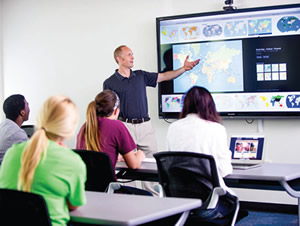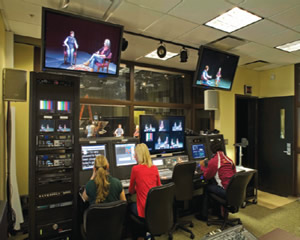Putting IT Together

PHOTO COURTESY OF TEXAS A&M UNIVERSITY-COMMERCE MARKETING COMMUNICATIONS
No doubt about it — today’s classrooms are high tech. With everything from digital projectors and amplification systems to intelligent lecterns and advanced lighting, faculty have more presentation options than ever. But when it comes to installing, maintaining and training users in classroom technologies, which approach is best? Relying on internal staff? Or retaining external consultants?
“It doesn’t have to be an either/or decision,” says Gary Bailer, director of product management, information display products for Sharp Imaging and Information Company of America.
“The institution should determine its own internal strengths and weakness to see where internal resources could provide value to their stakeholders,” he says. “Where they can’t install and train, outside resources should be deployed.”
Like Bailer, other experts see value in both approaches. Here are the reasons they cite.
Why an On-Campus Specialist is the Best Choice
“We know our clients best and we have a vested interest in a project’s success. We have long-standing relationships with many faculty, staff and students that bridge decades. This allows us to have a deep understanding of their needs and tailor solutions to match. As a residential university, our goal is to provide the best on-campus experience possible. Having the ability to design, implement and train users lets us build systems that are innovative as well as easy to support and maintain, contributing to a lower overall cost of ownership.”
— Mike O’Mara, manager, Learning Environments – ITS, Syracuse University
“An on-campus specialist can provide a unique and personalized approach of meeting the needs of the faculty when it comes to using any product involving technology.
“Every campus has a team of specialists that not only support instructional technology resources on campus, but also are the experts when it comes to their equipment.”
— Mike Broderick, CEO, Turning Technologies
“Some of the technology vendors in this space now provide more support to end-users who wish to self-manage. Some provide free design services and free inclass training, depending on the volume of the investment. Design technology has also improved over the years, making it simpler to develop and maintain customizations.
“If your organization is going to rely on these technologies across a significant percentage of classrooms or meeting spaces, it may be wise to have the on-staff resources necessary to diagnose technical problems. Or, if on-staff expertise will assist in improving the usefulness of the technology as devices in the classroom change or new features and functionality are conceived, it may be good to have a resource onstaff.”
— Joe Mancini, executive director of Technical Services, Montgomery County Community College (Pennsylvania)
“An on-campus specialist is able to deliver the highest level of support to faculty and students. The specialist will know the clients on a more personal level and understand levels of expertise. Additionally, the specialist likely will have a better understanding of the campus mission and key initiatives that impact the classroom environment.”
— Brian A. Rellinger, chief information officer, Ohio Wesleyan University
“Institutions will often leverage existing on-campus resources in the deployment, training and maintenance of classroom technologies for a couple of reasons.
“First, they get to leverage the existing experience and knowledge of specialists that are already familiar with the environment and the objectives for the institution. There are advantages to working with folks that already understand the values, beliefs and goals of the institution and that can already easily navigate the existing environment.
“The other main reason comes down to cost: they’re leveraging resources that are already funded.”
— Craig Walford, senior vice president of Services and Customer Success, D2L
“An on-campus specialist is more likely to understand what will and will not work for the faculty of a specific school. Our IT personnel maintain close relationships with faculty members in order to develop a strong understanding of their current and potential future needs. As a result, they are able to identify emerging technologies that will be of value to our faculty and students.
“Another reason higher education institutions may choose to rely on an on-campus specialist to install, maintain and train users in classroom technologies is to avoid troubleshooting issues in the future. We’ve found that relying on an outside vendor for maintenance and training could sometimes slow down the response time for repairs. Having these professionals on-site helps ensure their availability in case of an emergency or malfunction.”
— Michael Statmore, CIO, Post University
“An on-campus specialist will provide the most benefit when deep organizational knowledge is needed, or when organizational knowledge or experience is acquired during a project and needs to be retained. They are also beneficial where organizational efficiencies are a concern, and high-interaction is facilitated by proximity.”
— Randy Davis, CIO, American College of Education
Why an Off-Campus Consultant is the Best Choice
“The two reasons we look to outside help are a lack of capacity to meet demand, or lack of expertise with a highly-specialized system. The number of projects we’re being tasked with is steadily growing. To meet this uptick in demand, we often look for help on design of large projects and installation labor during peak periods. System complexity and specialization is growing rapidly as well. Until we can get staff trained to meet the need, we often look to an outside vendor to fill the gap.”
— Mike O’Mara, manager, Learning Environments – ITS, Syracuse University

PHOTO COURTESY OF AYERS SAINT GROSS
PLUG AND PLAY. The integration of technology, from projectors to amplification systems, intelligent lecterns, WiFi, simulation environments and more, into campus learning spaces takes an expert’s knowledge and touch. Ongoing support for installed technologies is also an important part of managing these systems. Administrators should weigh the pros and cons of hiring outside consultants versus relying on in-house experts in order to achieve the goal of efficient, useful and cost-effective technology.
“A well-rounded and well-oiled machine starts with a strong infrastructure on campus. Many times campus resources are limited, so leaning on outside consultants can help all parties involved. Turning Technologies takes great pride in assisting these on-campus professionals by connecting them with our Implementation Specialist Team. The collaboration that takes place leads to customized resources, pedagogical ideas in advancement of product use, train-the-trainer events, review of support strategies through the university’s website and much more.”
— Mike Broderick, CEO, Turning Technologies
“If an implementation only involves a few rooms, it may not be feasible to invest in the staff to learn and manage this technology. Or, if an institution simply doesn’t have the resources to commit, it may be necessary to hire an integration firm.”
— Joe Mancini, executive director of Technical Services, Montgomery County Community
College (Pennsylvania)
“Outside consultants may have more time to focus on the specific technologies and may be more aware of new product offerings from vendors, since they are likely to be more focused in this area.”
— Brian A. Rellinger, chief information officer, Ohio Wesleyan University
“There are several reasons why an institution would look to leverage an outside consultant:
“Outside consultants enable the institution to leverage a broad industry expertise and experience that may not be available within the institution — and might be needed to help facilitate the desired outcome.
“Outside consultants can also bring in new ideas, approaches, and explore the realm of the possible, while sharing patterns of success at other institutions that could be applied to the current situation.
“Another reason is to supplement the skills and resources already present within the institution, helping to accelerate achievement of the desired outcome.”
— Craig Walford, senior vice president of Services and Customer Success, D2L
“As we continue to integrate new classroom models, we have sought direction from outside help in finding the right technology to meet our students and professors’ needs. Incorporating expertise from external professionals helps guarantee that our classrooms remain ‘ahead of the curve’ in terms of modern learning technologies.”
— Michael Statmore, CIO, Post University
“Outside consultants are valuable when specific domain knowledge is needed but is not resident on the on-campus team. This is particularly beneficial when this knowledge does not need to persist after project completion. They also can provide flexibility in scale when required for a fixed duration of time.”
— Randy Davis, CIO, American College of Education
Meeting the Common Goal
Whether internal or external personnel play the dominant role, the objective is the same.
“The end goal is to integrate technology so that it blends into the classroom,” says Ohio Wesleyan’s Rellinger. “It’s important to make it as easy to use as possible, otherwise clients will become frustrated and usage will decline. Campus leaders should make classroom decisions in collaboration with IT and faculty to ensure the best chances of a successful integration and ongoing usage.”
This article originally appeared in the issue of .